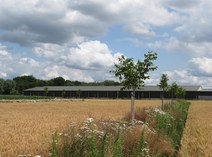Arable agroforestry systems in Flanders

Recently, a renewed interest for agroforestry is taking place in temperate Europe, since the implementation of this type of cropping system is associated with several beneficial effects on the (agricultural) environment such as carbon sequestration, increased soil fertility and water quality, reduced soil erosion, etc.
What we do
We quantify the impact of tree row presence on:
- Soil organic carbon and soil nutrient concentrations
- The presence of potentially beneficial (ground-dwelling) arthropods
- Yield and quality of arable intercrops
Benefits and drawbacks
- Soil organic carbon & soil nutrient concentrations are higher in arable fields near tree rows.
- Abundance & diversity of macro-detritivorous arthropods are higher near tree rows and the adjacent arable zone.
- Tree presence results in a decreased yield of arable crops. Relative yield losses are however strongly dependent on tree and intercrop species. Both positive (e.g. crude protein content) and negative (e.g. ripening stage) effects on crop quality can occur.
